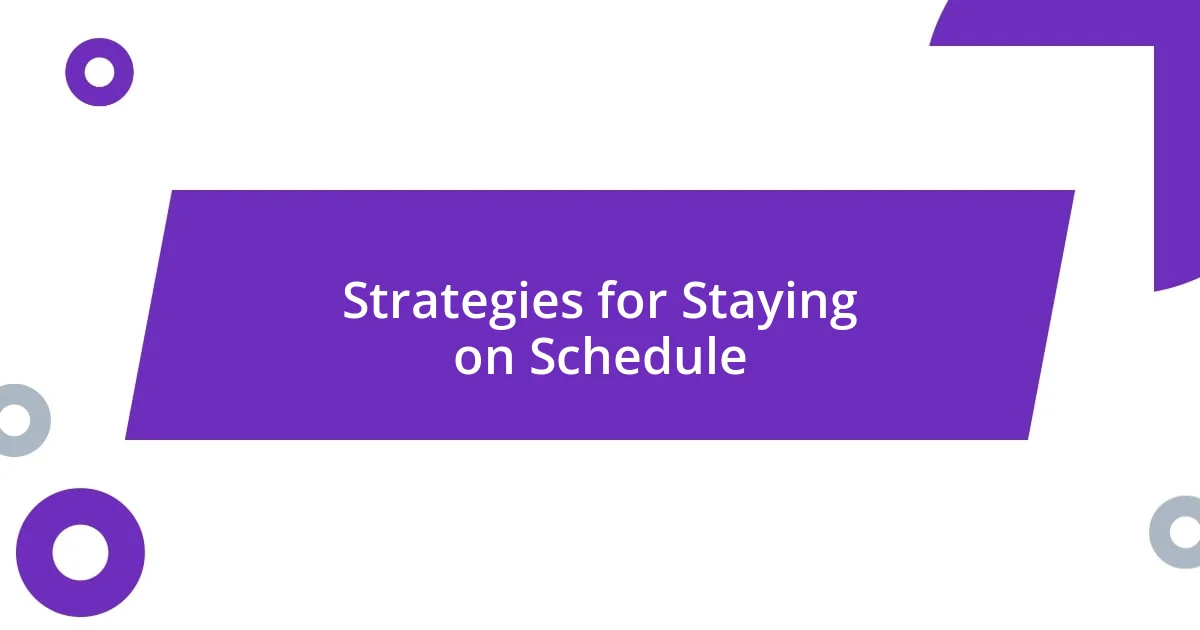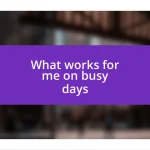Key takeaways:
- Event timelines serve as essential roadmaps, improving clarity and communication among all parties involved, which helps prevent chaos during gatherings.
- Setting clear goals is crucial for aligning efforts, measuring success, and maintaining team morale throughout the event planning process.
- Utilizing effective tools and strategies, such as project management software and time blocking, aids in managing timelines and troubleshooting common issues efficiently.

Understanding Event Timelines
An event timeline is essentially a roadmap for planning any gathering, whether it’s a wedding, conference, or community festival. I remember the first time I immersed myself in creating a timeline for a friend’s wedding; I felt both exhilarated and overwhelmed. Did I miss any key details? Crafting a timeline requires meticulous attention to detail, ensuring that all aspects of the event unfold smoothly and on schedule.
One crucial aspect of an event timeline is the clarity it provides to all involved parties. I’ve seen how effective timelines keep vendors, participants, and even guests informed. By having a visual representation of the day’s events, everyone can align their expectations and responsibilities. Have you ever attended an event that felt chaotic? That’s often because someone didn’t have a clear timeline to follow.
In my experience, the beauty of a well-structured event timeline lies in its flexibility. While it’s important to stick to the plan, unexpected changes can arise—think about a sudden rain shower during an outdoor event or a late arrival of a key speaker. I’ve learned that incorporating buffer time within your timeline can be a game changer. This way, you can adapt without causing too much stress, ensuring that the event remains enjoyable for everyone involved.

Importance of Clear Goals
Setting clear goals at the outset of any event is vital. I vividly remember an art exhibition I organized where we lacked a specific target. Without knowing whether to prioritize visitor numbers or artwork sales, the whole event felt disjointed. When everyone knows the goals, whether it’s raising funds, boosting attendance, or creating engagement, it streamlines efforts and minimizes misunderstandings.
Here are a few reasons why clear goals are crucial for event timelines:
- Focus: Defined objectives keep everyone aligned and focused on what truly matters.
- Measurement: Clear goals provide a benchmark for evaluating success post-event.
- Coordination: When vendors and team members understand the goals, they can coordinate their efforts more efficiently.
- Morale: Knowing what we’re working towards can boost the motivation and energy levels of the whole team.
In my journey, I’ve found that well-articulated goals not only direct planning but also create a sense of purpose. I recently attended a charity gala, and the energy was palpable because everyone understood the mission we were supporting. That shared understanding transformed the atmosphere, making the event feel like a collective achievement rather than just a series of tasks.

Steps to Create Effective Timelines
When creating effective timelines, the first step is to break down your event into manageable tasks. I’ve found that mapping out each element—like setting the date, booking vendors, and organizing logistics—can be quite liberating. After helping a friend plan her baby shower, we listed all our tasks on sticky notes, each representing a step in the process. This visual breakdown made it much easier to prioritize and tackle things one at a time, reducing the feeling of overwhelm.
Next, I emphasize the importance of setting deadlines for each task. For every gathering I’ve worked on, I’ve realized that without deadlines, things tend to stretch on indefinitely. I learned this the hard way during a corporate retreat I was involved in; we didn’t assign firm deadlines for securing speakers. As a result, we found ourselves scrambling at the last minute. By assigning dates to each task, I can create a sense of urgency and ensure that everything stays on track.
Lastly, I always build in time for revisions and feedback. I remember working on timelines for a community festival and realizing mid-way that some festival activities overlapped. I quickly gathered the team for a brief meeting to adjust the timeline, and it reminded me how essential collaboration is. Engaging others provides different perspectives that can improve the timeline and ensure a well-rounded event. Having these open lines of communication not only enhances cooperation but also strengthens relationships among team members.
| Step | Details |
|---|---|
| Break Down Tasks | Map out all event elements for clarity. |
| Set Deadlines | Assign firm dates to maintain urgency and direction. |
| Build in Feedback | Incorporate team input for a more robust timeline. |

Tools for Managing Event Timelines
Managing event timelines can be significantly streamlined with the right tools. In my experience, project management software like Asana or Trello has transformed the way I oversee tasks. I remember feeling overwhelmed during a large conference planning session, so I created a shared board that allowed everyone to see their responsibilities at a glance. This not only kept the team informed but also fostered a sense of accountability, which was key in hitting our deadlines.
I’ve also found that timeline templates can save a tremendous amount of time and effort. One time, I stumbled upon a visually appealing template that laid out tasks along a timeline. It was like picturing the entire event in one frame. By seeing the different phases of the event side by side, I was able to identify potential bottlenecks early on, which is crucial when you’re managing multiple moving parts. How do you visualize your projects? Finding a method that resonates with you can make all the difference.
Lastly, don’t underestimate the power of communication tools. For instance, using platforms like Slack for quick check-ins can keep everyone in the loop. I vividly recall organizing a virtual fundraiser and relying heavily on quick updates through chat. This immediacy prevented potential misunderstandings and kept the momentum going. What tools have you relied on in your event planning? Finding the right combination can elevate your event management to the next level.

Strategies for Staying on Schedule
Staying on schedule during an event requires a bit of finesse and a keen sense of priorities. For me, one effective strategy is to create a countdown checklist. I remember preparing for a wedding where I used a simple Excel sheet to break down tasks by weeks leading up to the big day. Each week, I could check off completed items, which helped me visualize how close we were to the event. This not only kept me focused but also added a satisfying sense of achievement as I ticked items off the list. Have you ever tried a visual countdown approach? It can be incredibly motivating.
Another strategy I’ve adopted is the practice of time blocking. I block specific times in my calendar for particular tasks, much like scheduling appointments. During one project, I learned that designating an hour each day to finalize vendor contracts kept them fresh in my mind and prioritized among other responsibilities. I was less likely to procrastinate, and the clarity of knowing exactly when I’d tackle this task made a huge difference. How often do you find yourself sidelined by last-minute changes? Time blocking can be your best ally in such moments.
Additionally, I’ve grown fond of the “two-minute rule.” If a task will take two minutes or less, I do it immediately. I remember a time while organizing a charity event when I was flooded with small tasks—responding to emails or confirming details with the venue. Addressing them right away not only cleared my plate but also allowed me to focus on larger, more complex tasks later on. Have you tried this technique? You’d be surprised at how efficiently it keeps your timeline on track by eliminating small delays from the equation.

Troubleshooting Common Timeline Issues
When facing common timeline issues, it’s essential to identify the setbacks early. I’ve experienced moments when unexpected hiccups, like a vendor canceling at the last minute, threw everything off course. In one instance, this happened just two days before a significant event, leaving me scrambling. Fortunately, I had a backup plan in place, which included alternative vendors I could reach out to quickly. Have you ever found yourself in a similar situation, and did you have a safety net ready?
Another typical issue can arise when team members miss deadlines. I recall a project where one key contributor underestimated their tasks, impacting everyone else’s workload. To address this, I initiated brief daily check-ins for accountability. This adjustment not only kept the team informed but also transformed a stressful atmosphere into one of collaboration. How do you keep your team’s morale high, especially under pressure?
Occasionally, I’ve discovered that unrealistic goals can lead to timeline chaos. Once, while planning a corporate retreat, I aimed too high with event objectives. The result was a timeline that felt more like a wish list than a feasible plan. Adjusting my goals to be more attainable made a significant difference. It relieved much of the pressure and led to a much smoother execution. What strategies do you have in place for managing expectations? Sometimes, realistic timelines can be your biggest ally in event planning.

Evaluating Event Timeline Success
Evaluating the success of an event timeline is all about reflection and analysis. After an event, I often take time to review how closely we stuck to our timeline. I remember one conference I managed where I didn’t meet the scheduled breaks, and attendees grew restless. I learned that timely breaks were just as crucial as the keynotes in maintaining energy levels. How do you measure attendee satisfaction in relation to your timeline?
Another aspect to consider is feedback from both the team and the participants. I once gathered insights after a team-building event, and surprisingly, several colleagues mentioned that we rushed through activities, which made them feel disconnected. This feedback prompted me to adapt future timelines, allowing for more flexibility and flow. What insights have you gained from participant feedback?
Ultimately, I find that reviewing outcomes against our original goals is essential. If the main purpose was to engage participants, but timelines hindered interaction, that’s a clear signal to reassess methodologies. I once underestimated the time needed for Q&A sessions during a workshop, and the lack of engagement was evident. It prompted a strategy adjustment for subsequent events. Have you ever had goals in mind that your timeline simply didn’t allow for?














